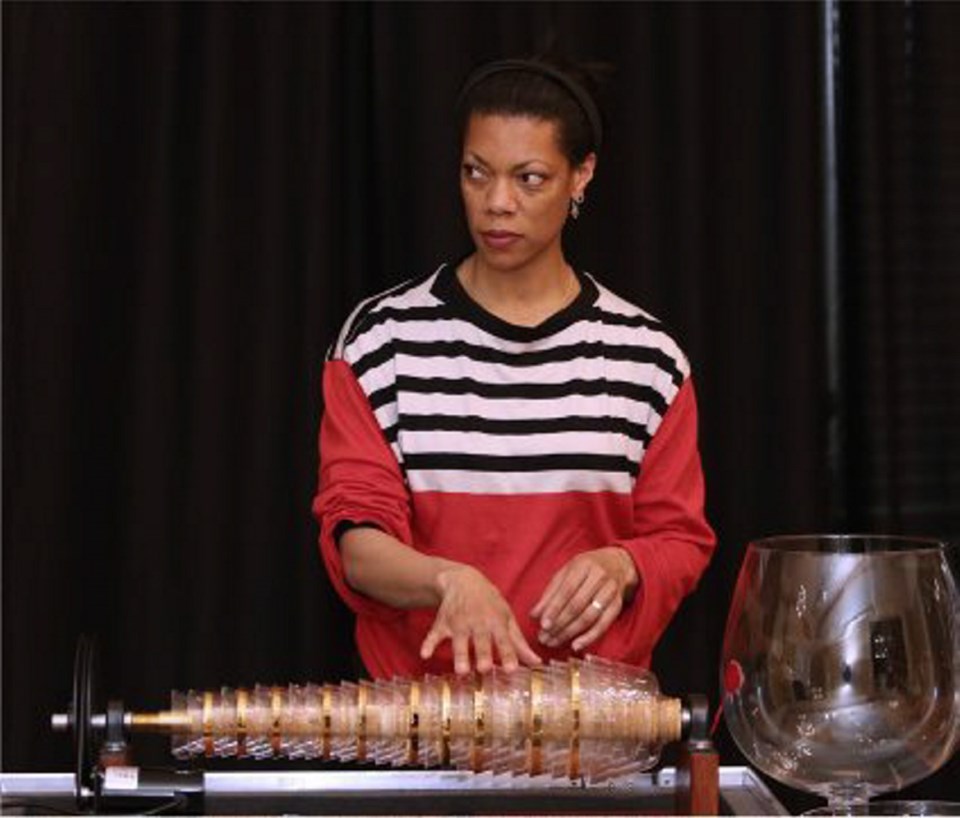What: Songs for Glass Island
Where: Art Gallery of Greater Victoria (also Vancouver’s Contemporary Art Gallery on Saturday, 7 p.m.)
When: Tonight 7 p.m., Friday 1 p.m.
Admission: $25 ($20 for AGGV members)
Back in 1970, American artist Robert Smithson hatched a peculiar idea. He wanted to cover a patch of bare rock near Thetis Island with 100 tons of broken glass.
The artwork was to be called Island of Broken Glass.
It never came to be — environmentalists vociferously opposed the notion. However, Smithson soon found world renown with his legendary earthwork, Spiral Jetty, a 460-metre mud construction on the shore of Utah’s Great Salt Lake.
Now, a Victoria band of experimental sound artists has created a new composition, Songs for Glass Island, taking inspiration from Smithson’s never-realized project. Tonight, the Experimental Music Unit debuts the piece at the Art Gallery of Greater Victoria, playing such glass “instruments” as windows, bottles, vases. . . even a circular picnic-table top. A scientific glass blower from the University of Victoria has provided custom-made flutes and tubes.
The Experimental Music Unit will be joined by Camille Norment, a globally acclaimed artist/musician who will play the glass armonica, a rare instrument invented by U.S. Founding Father Benjamin Franklin. Also known as the bowl organ, the glass armonica uses mechanically rotated glass bowls to create music. It is sounded with fingers, similar to rubbing a wine glass with a wetted finger.
“The sound is extremely visceral. It’s a very pure crystalline sound,” Norment said.
An American artist based in Oslo, Norment drew international notice last year when her large-scale installation Rapture was exhibited at the Venice Biennale’s Nordic Pavilion. That artwork, representing Norway, was dominated by giant panes of broken glass and used a soundtrack featuring the glass armonica. Norment has also performed and exhibited at New York’s Museum of Modern Art.
She transported her own glass armonica to Victoria from Oslo. Only one company in the world, based in Massachusetts, makes them. Norment’s is a compact travel model; its 24 glass bowls span two octaves.
Glass armonicas are few and far between, she said.
“I heard there were a couple in Toronto, but I’m not sure they’re in working condition.”
The instrument has an unusual history. Franklin invented the glass armonica in 1761 after watching wine glasses being played. His contraption was operated with a treadle, in the manner of a sewing machine.
The glass armonica became widely popular, with Beethoven, Mozart and Richard Strauss composing for it. Marie Antoinette was among those who took lessons. Curiously, the glass armonica fell out of favour in the 18th century (and was even banned) after some insisted the eerie sound caused melancholia and even madness.
Norment said she’s attracted to the glass armonica not only by its sound, but by its history. As an artist, she’s particularly interested in cultural psycho-acoustics — the study of how people react to sound and music on a cultural as well as physical level.
“Sound becomes culture the minute it excites the ear. That’s because we belong to culture, we belong to societies, and it’s our brains that are processing these vibrations as sound,” Norment said.
Her connection with Victoria is Paul Walde, a member of the Experimental Music Unit with Tina Pearson and George Tzanetakis. Norment and Walde met as graduate students at New York University. Long interested in environmental art, Walde’s past projects include Requiem for a Glacier, a 2013 performance for 50 musicians at Farnham Glacier in the Kootenays.
Glass looms large in Norment’s artwork, both sonically and visually. While collaborating on Songs for Glass Island, she thought about the failed glass-island dream of Smithson, who died in a plane crash in 1973 at the age of 35. Norment also pondered other glass imagery.
“I thought of phrases such as ‘the glass ceiling’ for example. And glass as this invisible barrier. And recently, I’ve been working with this idea of a message in a bottle. I love that idea.”



